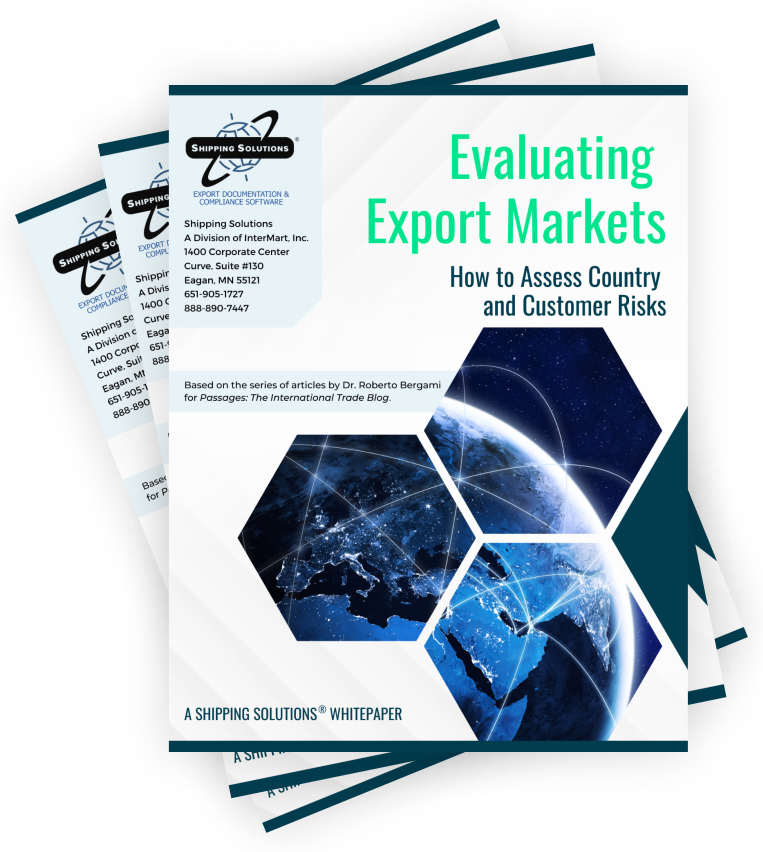The International Trade Blog International Sales & Marketing
Import-Export Due Diligence: Measuring Competitiveness
On: November 15, 2023 | By:  Roberto Bergami |
6 min. read
Roberto Bergami |
6 min. read
 This is the sixth part in my series of articles on country and customer risk assessment.
This is the sixth part in my series of articles on country and customer risk assessment.
To review, it is important to analyze both countries and customers, because a rogue customer in a good (from a risk perspective) country is not a much better risk than a good customer in a rogue (from a risk perspective) country.
In my last article, I discussed the last five business categories measured in the Doing Business: Measuring Business Regulations project. In this article, I will discuss the competitiveness data from the World Economic Forum. Remember these data are freely available from the World Economic Forum website.
The Importance of Business Competition
Whether you are a trader or a service provider, competitiveness considerations are highly important. Competition is what drives us to be more successful than others. Fair competition is good; unfair competition is not good.
So-called predatory behavior is not a good approach to doing business as it typically works on the exploitation of the weak, who are typically disadvantaged and, consequently, victimized. This behavior has questionable ethics, to say the least. It is important to remain human, even when engaged in business dealings.
The World Economic Forum (WEF) dates back to January 1971 when a group of European business leaders met under the patronage of the European Commission and European industrial associations. The initial meetings focused on how European firms may be able to catch up with United States management practices. The European Management Forum was set up in those early days, and its name was changed to the World Economic Forum in 1987.
The activities of the WEF have gradually expanded to include a number of international projects including health and hunger issues. Importantly, in the context of this series of articles, WEF has developed a knowledge center where freely accessible useful information and reports may be found. One such report is the Global Competitiveness Report, the latest one of which is the 2020 edition.
Global Competitiveness Report
This report measures the competitiveness of economies across 12 pillars, as outlined below. Linking comments to business processes are provided, as appropriate, under each pillar.
1. Institutions
"The institutional environment of a country depends on the efficiency and the behavior of both public and private stakeholders."
Issues that fall within this pillar include regulations and bureaucracy (red tape), transparency and government policies and their implementation.
2. Infrastructure
"Extensive and efficient infrastructure is critical for ensuring the effective functioning of the economy."
Infrastructure is a critical component of the business environment and it processes as it affects things such as transportation, energy supply and distribution, and communication. These in turn affect the economic efficiency of a country.
3. Macroeconomic Environment
"The stability of the macroeconomic environment is important for business and, therefore, is significant for the overall competitiveness of a country."
Government fiscal policies, interest rates and inflation are issues that fall within this pillar—with an obvious impact on business.
4. Health and Primary Education
"A healthy workforce is vital to a country’s competitiveness and productivity. Workers who are ill cannot function to their potential and will be less productive. Poor health leads to significant costs to business, as sick workers are often absent or operate at lower levels of efficiency. Investment in the provision of health services is thus critical for clear economic, as well as moral, considerations. In addition to health, this pillar takes into account the quantity and quality of the basic education received by the population, which is increasingly important in today’s economy. Basic education increases the efficiency of each individual worker."
A poor health system negatively impacts productivity, and a poor education system limits a worker's ability to be involved in more advanced processes and also limits their ability to be innovative.
5. Higher Education and Training
"Quality higher education and training is crucial for economies that want to move up the value chain beyond simple production processes and products."
It is commonly accepted that a more highly educated workforce positively contributes to economic success for a nation overall and also for individual firms. Higher education levels enable workers to be part of more sophisticated and complex processes and be at the cutting edge of innovation. Research activities associated with future growth and development typically occur in nations with higher-skilled workers. This has implications for foreign investment, sourcing opportunities and developing/penetrating new sales markets.
6. Goods Market Efficiency
"Countries with efficient goods markets are well positioned to produce the right mix of products and services given their particular supply-and-demand conditions, as well as to ensure that these goods can be most effectively traded in the economy."
Marketplace competitiveness, as reflected by the amount of regulation and competitive behavior rules, is an important aspect of doing business. Within this pillar issues such as taxes, business ownership and attitudes towards foreign direct investment (FDI).
7. Labor Market Efficiency
"The efficiency and flexibility of the labor market are critical for ensuring that workers are allocated to their most effective use in the economy and provided with incentives to give their best effort in their jobs."
Mobility of labor between industries is a factor considered within this pillar. Ideally, workers should be able to transfer across industries easily and with little wage fluctuation.
8. Financial Market Development
"An efficient financial sector allocates the resources saved by a nation’s population, as well as those entering the economy from abroad, to the entrepreneurial or investment projects with the highest expected rates of return rather than to the politically connected. Business investment is critical to productivity. Therefore economies require sophisticated financial markets that can make capital available for private-sector investment from such sources as loans from a sound banking sector, well-regulated securities exchanges, venture capital, and other financial products."
The global financial crisis certainly highlighted the need for a banking sector that is trustworthy and transparent, one that operates in a prudentially controlled environment with adequate regulation on securities and other financial products. Finance is the lifeblood of any business.
9. Technological Readiness
"The technological readiness pillar measures the agility with which an economy adopts existing technologies to enhance the productivity of its industries, with specific emphasis on its capacity to fully leverage information and communication technologies (ICTs) in daily activities and production processes for increased efficiency and enabling innovation for competitiveness."
This pillar does not include innovation, rather it considers the ability of a nation to adopt technology and absorb it. This is often achieved through FDI through which new technologies may become available.
10. Market Size
"The size of the market affects productivity since large markets allow firms to exploit economies of scale. Traditionally, the markets available to firms have been constrained by national borders. In the era of globalization, international markets have become a substitute for domestic markets, especially for small countries. Thus exports can be thought of as a substitute for domestic demand in determining the size of the market for the firms of a country."
We know that globalization has assisted in opening up markets, although barriers still exist. Foreign countries, however, remain good sources of potential additional sales (beyond domestic borders) and also provide opportunities for different sourcing options. Both of these aspects can be quite beneficial for firms.
11. Business Sophistication
"Business sophistication concerns two elements that are intricately linked: the quality of a country’s overall business networks and the quality of individual firms’ operations and strategies."
Clustering, that is the interconnection of firms from close-by geographical areas, allows for increases in efficiencies and optimization of processes, while at the same time reducing barriers to entry.
12. Innovation
"Innovation is particularly important for economies as they approach the frontiers of knowledge, and the possibility of generating more value by merely integrating and adapting exogenous technologies tends to disappear. In these economies, firms must design and develop cutting-edge products and processes to maintain a competitive edge and move toward even higher value-added activities."
Technological innovation is where the biggest benefits come from. For this to occur, though, there needs to be investment in research and development from both public and private sectors. In the private sector, this is typically through financing projects; in the public sector, it is typically through the provision of higher education and the establishment of high-quality scientific research centers in, usually, universities.
The Interrelation of the 12 Pillars
Although there are 12 different pillars, some of these are linked. For example, it would be difficult to imagine how innovation (pillar 12) could exist without financial investment (pillar 8) in a nation where high levels of healthy well-educated individuals can participate in the workforce (pillars 4 and 5); where there is an efficient market (pillar 6) that can absorb new technologies (pillar 8).
What is the benefit of this information to an existing or would-be exporter or importer? By combining the different data in the report, we can consider to what degree a nation meets certain requirements that we may seek as an exporter or an importer.
For example, as an exporter, we would be interested to find out what sort of market mechanisms may be in place to ensure fair competition. If we are an importer, we may be interested in the education of the workforce as this is likely to impact the quality of supplies sourced from that nation. Innovation is important to both exporters and importers, as innovative ideas potentially generate ideas for different uses for existing products or the development of new products.
In my next article, I will look at banks and their role in international trade finance facilitation and the notion of banks risk.
Like what you read? Subscribe today to the International Trade Blog to get the latest news and tips for exporters and importers delivered to your inbox.
This article was first published in October 2013 and has been updated to include current information, links and formatting.

About the Author: Roberto Bergami
A full time member of staff at Victoria University, Melbourne, Australia, since 1998, Roberto holds a PhD (Thesis title Risk Management in Australian Manufacturing Exports: the Case of Letter of Credit to ASEAN), a Master in Education and Master of Business by Research (Applied Economics). Roberto additionally holds the Certified Documentary Credit Specialist qualification.
He is currently a Senior Lecturer in the College of Business and Visiting Professor at the University of South Bohemia in Ceske Budejovice, the Czech Republic. Roberto is also an Associate Researcher of the Centre for Cultural Diversity and Wellbeing and the Centre for Strategic and Economic Studies. Roberto has maintained his involvement with industry through a number of peak associations where he enjoys various grades of senior level membership.
Roberto’s main areas of research interests in international trade focus on government regulations, delivery terms (Incoterms), international payment terms and market entry barriers. His other research interests include the development of communities of practice, online teaching and online communities, migration from Emilia-Romagna (Italy) to Australia and teenage/youth dialect.



